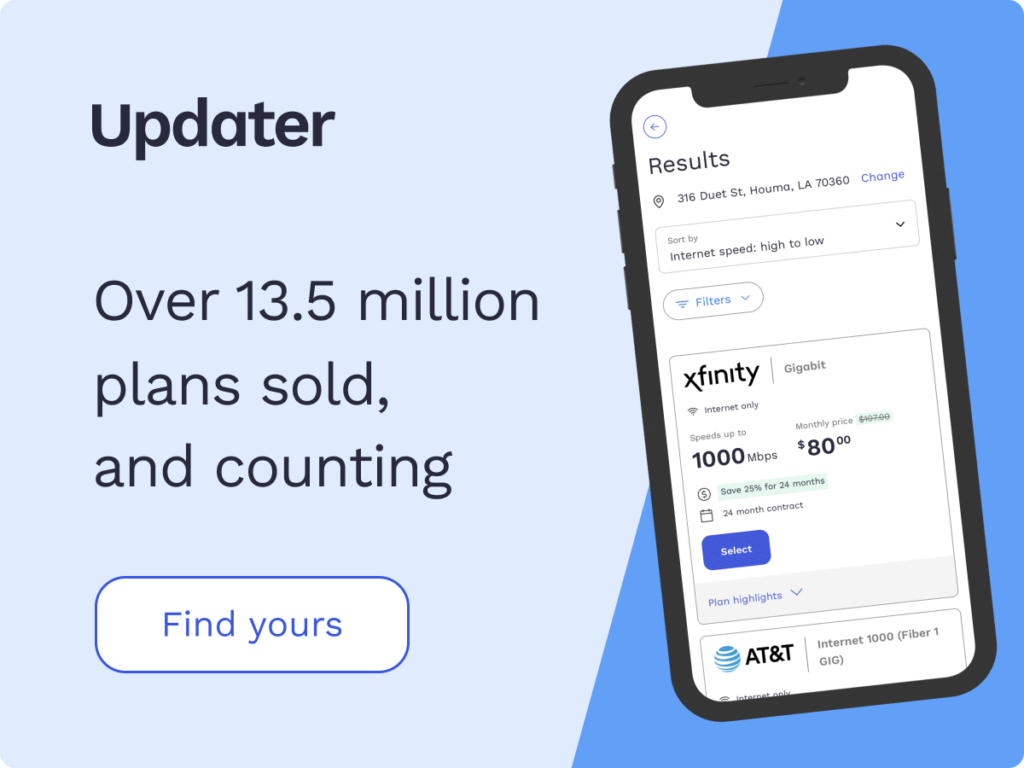How to Transfer Your Internet Service

The average American will move 11 times in their lifetime. Moving can be a challenging process, and knowing how to transfer your internet service can make settling into your new home easier. Some common steps include letting your provider know that you’re moving, inquiring about moving your service, looking for discounts, checking reviews, and testing your speed after you finish moving. This handy guide can let you know how to transfer internet service quickly, affordably, and easily.
- Let your provider know you’re moving
- Ask about moving your internet service
- Look for discounts and bundles
- Check internet service provider reviews
- Setting up your internet service
- Run an internet speed test
- Frequently asked questions (FAQs)
Let your provider know you’re moving
Whether you want to keep your current internet service provider (ISP) or not, letting them know that you plan to move is an important step in the process. Contact your ISP a few weeks before your move and let them know when you want service disconnected at your current address. Also, check to see if your current ISP can provide service at your new address.
Some condo and homeowners associations have strict rules about outdoor installation. Some types of service, like satellite internet, may not be allowed, and you may need to be careful about the companies or plans you choose as a result. You can contact your landlord, condo, or homeowners association to find out about any restrictions on internet service or equipment at your new place.
Ask about moving your internet service
Before you decide whether you want your service transferred to your new address, you should compare prices and plans from several ISPs. Do your research on available internet transfer deals. Your current company may offer different service packages to transfer internet to a new address and with most ISPs, you can transfer your service over the phone or online.
If your new home has a very different size or configuration than your old one, you could need another plan. Larger homes or properties with multiple buildings often require multiple routers to broadcast Wi-Fi effectively and avoid dead zones. Rooms on high floors are ideal for placing routers because the Wi-Fi signals they produce naturally move out and down, away from the broadcast source.
Look for discounts and bundles
Don’t grab the first plan you see. Instead, ask which discounts you qualify for so that you can decide which plan is best for your new address.
If you work from home or enjoy online gaming, you may need a more powerful internet connection. Most people don’t need more than 50Mbps download speeds, but high-graphics gaming and jobs that use complex computer modeling can require double that speed or more. Make sure you know what level of internet service you’ll need. That way, you can avoid wasting money on large amounts of capacity you’ll never use. Households with more internet users generally need stronger internet connections, and having more speed than you need is better than not having enough.
If you choose a plan that’s too slow for your family’s work and recreational needs, everyone could experience lagging and other issues. Some ISPs offer bundles with other services, such as TV, landline phone service, and cell phone service. Signing up for bundled services can help you save money and make transferring your utilities to a new address easy.
Check internet service provider reviews
Before you decide whether you want to transfer your internet service or try a new company, checking out reviews can give the information you need to make an informed decision.
Spectrum
According to U.S. News & World Report, Spectrum is the second-largest ISP in the United States and the best ISP for rural areas. In 2021, the company provided service in 41 states, making it likely you can transfer your Spectrum internet service.
Cox
In the 2021 U.S. Residential Internet Service Provider Satisfaction Study, J.D. Power gave Cox a 708 out of 1,000 for the East region, a 703 for the North Central region, a 707 for the South region, and a 711 for the West.
“Cox is currently the largest private telecom company in the U.S., serving more than six million residences and businesses in 19 states. Although its main offering is cable internet, Cox also offers fiber optic internet to customers in select areas. Currently, the internet provider has 30,000 miles of what it calls “Metro Fiber” in place. Cox Communications was founded more than 50 years ago and is still a family-owned company.” – U.S. News and World Report
AT&T
ZDNet says that AT&T has the second most expansive fiber network, fast speeds, and outstanding reliability. However, people in rural areas may be limited to slower DSL. AT&T plans come with unlimited data and there’s not contract required if you choose an internet package from AT&T.
The American Customer Satisfaction Index gave AT&T internet service a 71% satisfaction rating in 2021, a 4% increase from 2020.
Kinetic by Windstream
“Those in rural areas will find Kinetic DSL internet to be a better service and value than satellite. Kinetic fiber and cable internet are somewhat more closely matched, but it’s probable that Kinetic fiber will be the cheaper high-speed option as well.” – CNET
Verizon Fios
PCMag called Verizon Fios the fastest major ISP in the United States for 2021. This is Fios’s ninth win of the decade.
CNET says Verizon Fios has internet service that’s tough to beat if you live in their East Coast coverage area. However, it’s only available in Washington, D.C., and eight states: Delaware, Massachusetts, Maryland, New Jersey, Pennsylvania, New York, Rhode Island, and Virginia.
Set up your internet service
When setting up your new internet service, the first step involves determining the infrastructure at your new location. If it isn’t wired for your specific provider, your ISP’s technicians can help. If installation is needed, it usually costs between $50 and $200. The exact cost depends on your location and the difficulty of the job. Larger homes or locations with multiple buildings could require more work and time to install internet access. To find out whether a location has had internet service before, ask the previous owners or inquire with local providers.
If you plug your old router into your new infrastructure and its initial lights turn on, you might only need to call the right service provider to have internet service activated. If you need infrastructure changes, your connection could take some time to establish. Make arrangements for an alternate connection, especially if you work from home.
Run an internet speed test
To make sure that your signal is what you paid for, you can use a free online internet speed test. You can just click a button to start the test and then get your results.
Active signal monitoring programs and apps are also available. They help you make sure that your connection isn’t throttled or compromised in another way. For example, without protection from a monitoring program, an unauthorized user could take advantage of your internet connection from a nearby location. The data the program analyzes can help your provider restrict your signal to authorized users. If your signal isn’t as fast as it should be, contact your ISP for help immediately.
Frequently asked questions (FAQs)
My signal dropped, but my router or modem is still active. How do I reconnect?
A lost connection is one of the most common internet issues. After moving, the need for a system update or an incompatible router or modem can sometimes lead to issues. Unplug your router and modem, and then plug it in a few minutes later to reset your device. If that doesn’t solve the issue, contact your ISP’s support department. If only one of your devices has trouble connecting, you could have a problem with settings, user permissions, or your computer’s antivirus software.
My internet usage spikes frequently, but I’m not using anything that would take up that much signal. What can I do to fix this?
An unauthorized user could be accessing your internet service. Your ISP can help you end this intrusion by changing your Wi-Fi password and showing you how to update your settings for increased security.
Why does my plan list a higher data number than my actual connection?
Some plans list the power of the network as a whole instead of the strength of the individual internet connection where you live. That’s why most ISPs say that particular plans can reach up to a certain speed. If you’re not getting the maximum advertised speed, ask your ISP if an upgrade to your home’s wiring could increase your speed.
I have many smart devices that I want to network through my provider’s service. How can I do that?
Your provider’s technicians will know how to integrate all of your devices into your network, including PCs, smart thermostats, and other devices. However, some ISPs have a limit on the number of devices you can connect to Wi-Fi.
Why isn’t my computer or other device getting a signal from the router in the next room?
Something in the wall could be obstructing your signal, or your settings could be interfering with your connection. Moving your router to another location could take care of the problem. You can also try turning it off for a few minutes and then restarting it. If necessary, you can contact your ISP and ask for a replacement.
If I live in a condo or apartment, do I need permission to hook up internet service?
You don’t need permission to start internet service, but notifying your landlord or condo association before an installation can help you prevent technical issues. It also makes complying with local laws and regulations easier. In some locations, the dish needed for satellite internet could be banned. In others, you may need new fiber optic cables to get the fastest speed available.
*Pricing varies by location and availability. Speeds may vary. All prices subject to change; for current pricing and availability visit our internet service page. Prices as of 4/1/22.
Enter your address to find out what providers and plans are available to you
Disclosure | Updater articles are based on our own data and research, independent from partner relationships. We are not compensated by partners for information and opinions presented here. Our Editorial Terms of Service can be found here.














